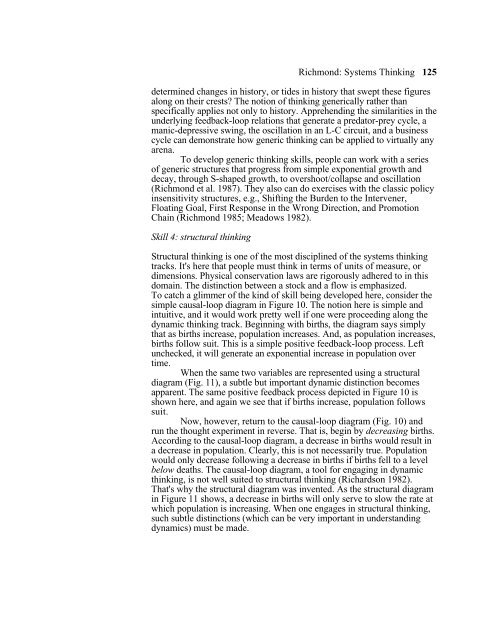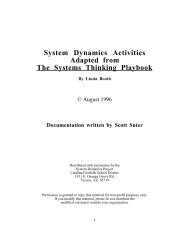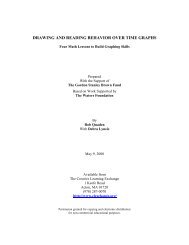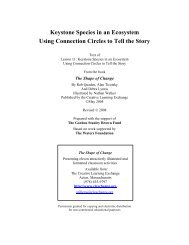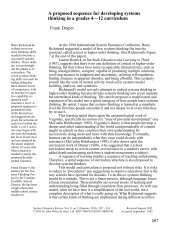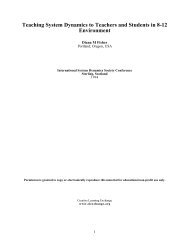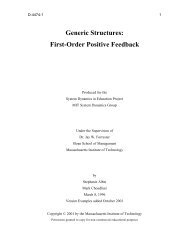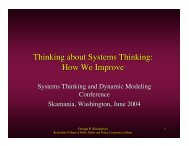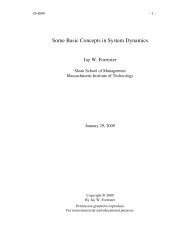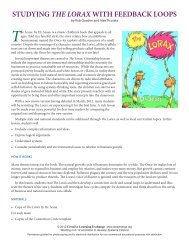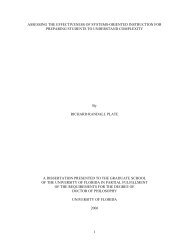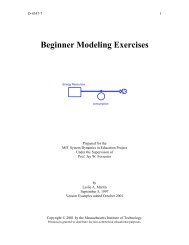Systems thinking: critical thinking skills for the 1990s and beyond
Systems thinking: critical thinking skills for the 1990s and beyond
Systems thinking: critical thinking skills for the 1990s and beyond
- No tags were found...
Create successful ePaper yourself
Turn your PDF publications into a flip-book with our unique Google optimized e-Paper software.
Richmond: <strong>Systems</strong> Thinking 125determined changes in history, or tides in history that swept <strong>the</strong>se figuresalong on <strong>the</strong>ir crests? The notion of <strong>thinking</strong> generically ra<strong>the</strong>r thanspecifically applies not only to history. Apprehending <strong>the</strong> similarities in <strong>the</strong>underlying feedback-loop relations that generate a predator-prey cycle, amanic-depressive swing, <strong>the</strong> oscillation in an L-C circuit, <strong>and</strong> a businesscycle can demonstrate how generic <strong>thinking</strong> can be applied to virtually anyarena.To develop generic <strong>thinking</strong> <strong>skills</strong>, people can work with a seriesof generic structures that progress from simple exponential growth <strong>and</strong>decay, through S-shaped growth, to overshoot/collapse <strong>and</strong> oscillation(Richmond et al. 1987). They also can do exercises with <strong>the</strong> classic policyinsensitivity structures, e.g., Shifting <strong>the</strong> Burden to <strong>the</strong> Intervener,Floating Goal, First Response in <strong>the</strong> Wrong Direction, <strong>and</strong> PromotionChain (Richmond 1985; Meadows 1982).Skill 4: structural <strong>thinking</strong>Structural <strong>thinking</strong> is one of <strong>the</strong> most disciplined of <strong>the</strong> systems <strong>thinking</strong>tracks. It's here that people must think in terms of units of measure, ordimensions. Physical conservation laws are rigorously adhered to in thisdomain. The distinction between a stock <strong>and</strong> a flow is emphasized.To catch a glimmer of <strong>the</strong> kind of skill being developed here, consider <strong>the</strong>simple causal-loop diagram in Figure 10. The notion here is simple <strong>and</strong>intuitive, <strong>and</strong> it would work pretty well if one were proceeding along <strong>the</strong>dynamic <strong>thinking</strong> track. Beginning with births, <strong>the</strong> diagram says simplythat as births increase, population increases. And, as population increases,births follow suit. This is a simple positive feedback-loop process. Leftunchecked, it will generate an exponential increase in population overtime.When <strong>the</strong> same two variables are represented using a structuraldiagram (Fig. 11), a subtle but important dynamic distinction becomesapparent. The same positive feedback process depicted in Figure 10 isshown here, <strong>and</strong> again we see that if births increase, population followssuit.Now, however, return to <strong>the</strong> causal-loop diagram (Fig. 10) <strong>and</strong>run <strong>the</strong> thought experiment in reverse. That is, begin by decreasing births.According to <strong>the</strong> causal-loop diagram, a decrease in births would result ina decrease in population. Clearly, this is not necessarily true. Populationwould only decrease following a decrease in births if births fell to a levelbelow deaths. The causal-loop diagram, a tool <strong>for</strong> engaging in dynamic<strong>thinking</strong>, is not well suited to structural <strong>thinking</strong> (Richardson 1982).That's why <strong>the</strong> structural diagram was invented. As <strong>the</strong> structural diagramin Figure 11 shows, a decrease in births will only serve to slow <strong>the</strong> rate atwhich population is increasing. When one engages in structural <strong>thinking</strong>,such subtle distinctions (which can be very important in underst<strong>and</strong>ingdynamics) must be made.


